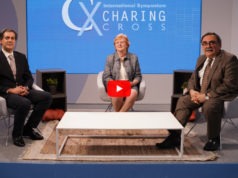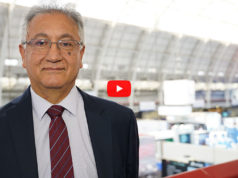
The first-ever 60-month data on Medtronic’s VenaSeal closure system were presented on Tuesday, indicating that at five years, treatment with the cyanoacrylate adhesive for closure of diseased vein segments was not inferior to the alternative treatment arm of radiofrequency ablation (RFA). Nick Morrison of the Center for Vein Restoration in Mesa, USA delivered the outcomes during a superficial venous session of the Venous & Lymphatic Challenges programme.
The data were the result of long-term outcomes from the VeClose study, in a five-year follow-up extension of the trial’s original three-year follow-up period. Morrison explained that in order to continue to assess the safety and efficacy of the VenaSeal closure system for the long-term effect of the closure, Morrison and colleagues “wanted to follow up as many patients as we could gather out to five years”. Of the original trial’s 222 patients, the extended VeClose study was able to enrol 89 patients, of which 47 had been randomised to VenaSeal cyanoacrylate and 33 randomised to RFA with Medtronic’s ClosureFast system; the remaining nine patients were roll-in cyanoacrylate patients.
The primary endpoint of the extension study was complete closure, defined as Doppler ultrasound examination showing closure along the entirety of the treated target vein, with no discrete segments of patency exceeding 5cm. Among the randomised patients, this endpoint of closure rates were sustained long term, with “no new failures reported and non-inferiority demonstrated through 60 months.” Morrison reported a 91.4% closure rate in the VenaSeal arm, versus 85.2% in the RFA arm.
The study further monitored changes in Venous Clinical Severity Score (VCSS), Aberdeen Varicose Vein Questionnaire (AVVQ), Quality of Life survey (EQ-5D) and clinical, aetiology, assessment and pathophysiology (CEAP) scores compared to baseline. Additional secondary endpoints included satisfaction with treatment, adverse events related to target great saphenous vein, and details of adjunctive procedures performed on the study limb. Both arms, Morrison noted, demonstrated “sustained improvement in disease-specific, generic quality of life and functional outcomes. […] No serious adverse events, pulmonary embolism, deep vein thrombosis or treatment limb related adverse events were reported between 36- and 60-month visits.”
Reducing the need for compression and anaesthesia
“VenaSeal uses an advanced medical adhesive to safely and effectively close the diseased vein segment”, Morrison said, outlining benefits of a treatment that is non-thermal, non-tumescent and non-sclerosant. One “main advantage” highlighted by Morrison is the rapid recovery period for patients, and importantly for patients living in warmer climates, a reduced need for compression stocking therapy post-procedure is key for patients “who just cannot tolerate compression hosiery. [With VenaSeal] there is no need for compression hosiery, which is very nice in a hot climate.” When choosing between the treatment modalities of RFA versus cyanoacrylate glue, Morrison tells CX Daily News that beyond this key benefit, the choice “comes down to practicality. Because we do not have to use a tumescent or anaesthesia, that is an advantage to patients—even if they may not be aware of it, if they have not had a procedure in the past—the lack of tumescent is certainly an advantage.”
The rapid recovery period is a factor that initially led Kathleen Gibson (Bellevue, USA) to consider VenaSeal an “ideal option” for a younger, less diseased patient population who value the ability to return to physical activity as soon as possible and are less inclined to wear stockings. However, Gibson adds that the cyanoacrylate therapy is further suited for the elderly with medical comorbidities, advanced venous disease and reduced mobility, who may not be able to apply their compression stockings.













I wonder if Medtronic is really telling providers the whole story. I first had venous ablation using Venaseal in September, 2018. I have had continuous ongoing problems since then, specifically in the small saphenous vein. My body has rejected the venaseal, and hardened pieces of glue continue to break through the vein, and then the skin. When this occurs, wounds in my ankle and calf have not healed for months at a time, and the pain as the glue exits the vein and skin is excruciating. Secondary to these complications, I now have chronic lymphedema in the treated leg. It has been just over a year since my venous ablation with Medtronic Venaseal, and I continue to experience ongoing painful complications. The three vein specialists that I have consulted have told me that Medtronic has underreported Venaseal complications, and they now warn patients, or completely avoid using it in the small saphenous vein. If my provider or I had been informed that a patch test was available, albeit discouraged by the manufacturer, I could have taken advantage of it, and likely avoided the ongoing pain and complications.
Oh wow! I’m sorry to hear that’ I have such reservations about all these procedures but especially venaseal. The vascular surgeon I talked to only offered that. But I worried about it dissolving and entering my deep system. Bso your in worse shape after the procedure?
Is it just in the small saphenous vein that they advise against?
This was my initial worry when I read about venaseal. What happens after the glue hardens. And slowly separates. It would travel through your blood steam or cause a blockage
I have had venaseal treatment for 18 days now. Still itchy on my skin. I wonder how long does the super glue stay in the vein and what’s gonna happen I’d they break into pieces. Will the glue pieces go into my blood stream.?